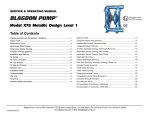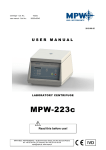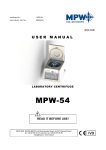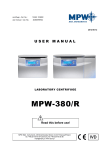Download User Manual - Equip-Test
Transcript
ASSEMBLY, INSTALLATION, AND REMOVAL OF CONTACTS AND MODULES FOR 20/26 GHz COAXIAL CONTACTS AND MODULES Table of Contents SECTION 1 RECEIVER CONTACT ASSEMBLY INSTRUCTIONS SECTION 2 ITA CONTACT ASSEMBLY INSTRUCTIONS SECTION 3 CONTACT INSTALLATION AND REMOVAL INSTRUCTIONS SECTION 4 MODULE INSTALLATION AND REMOVAL INSTRUCTIONS SECTION 5 CROSS REFERENCE TABLES SECTION 6 PRODUCT PERFORMANCE SPECIFICATIONS 2/8/10 20/26 GHZ COAXIAL CONTACTS AND MODULES USER’S MANUAL: SECTION 1 VIRGINIA PANEL CORPORATION 20/26 GHZ COAXIAL RECEIVER CONTACT ASSEMBLY PART # 610 102 109 FOR STRIPFLEX 142B, OR M17/60-RG142 610 102 116 FOR M17/84 RG-223 TOOLS REQUIRED Crimp Tool, Part # 910 101 124 Dimensions shown: [millimeters] inches ASSEMBLY INSTRUCTIONS 1. Strip wire and point center conductor (Figure A). 2. Slide crimp ring over wire and flair braid by rotating dielectric (Figure B). NOTE: Remove mylar foil on stripflex 142 cable. 3. Insert the barrel of the threaded crimp nut between the braid and dielectric, positioned so that the end of the cable dielectric is flush with the end of the threaded crimp nut (Figure C). 4. Using the Crimp Tool, Part # 910 101 124 (Figure D), slide the crimp ring against the shoulder of the threaded crimp nut and crimp using the larger hex position (Figure E). 5. Install and tighten the shield conductor assembly to 7-10 in-lbs [0.79-1.13 Nm] (Figure F). 6. Apply ¼” [6.4 mm] diameter 1” [25.4 mm] long shrink tubing over crimp ring up to shoulder of threaded crimp nut and shrink (Figure G). [5.8±0.3 ] 0.23±0.01 [14] 0.55 [3.3±0.4] 0.13±0.02 90° Figure A. Strip lengths. CRIMP RING BRAID DIELECTRIC Figure B. Apply crimp ring. CRIMP RING BRAID CRIMP NUT FLUSH Figure C. Apply threaded crimp nut; ensure the end of the dielectric is flush with the end of the threaded crimp nut. Figure D. Crimp Tool, Part # 910 101 124. CRIMPED RING Figure E. Crimp crimp ring. *It is recommended to use the following cables to achieve certain frequencies: StripflexTM 142B 26 GHz M17/84-RG223 12.4 GHz M17/60-RG142 8 GHz Figure F. Apply shield conductor assembly. SHRINK TUBING Figure G. Apply shrink tubing. 1-1 For more information visit vpc.com 2/8/10 VIRGINIA PANEL CORPORATION 20/26 GHZ COAXIAL CONTACTS AND MODULES USER’S MANUAL: SECTION 2 20/26 GHZ COAXIAL ITA CONTACT ASSEMBLY PART # 610 102 110 FOR STRIPFLEX 142B OR M17/60-RG142 610 102 117 FOR M17/84-RG223 TOOLS REQUIRED Crimp Tool, Part # 910 101 124 Dimensions shown: [millimeters] inches ASSEMBLY INSTRUCTIONS 1. Strip wire and point center conductor (Figure A). 2. Slide crimp ring over wire and flair braid by rotating dielectric (Figure B). NOTE: Remove mylar foil on stripflex 142 cable. 3. 4. 5. 6. [5.8±0.3 ] 0.23±0.01 Figure A. Strip lengths. CRIMP RING BRAID DIELECTRIC Figure B. Apply crimp ring. CRIMP RING Install and tighten the shield conductor assembly to 7-10 in-lbs [0.79-1.13 Nm] (Figure F). Apply ¼” [6.4 mm] diameter 1” [25.4 mm] long shrink tubing over crimp ring up to shoulder of threaded crimp nut and shrink (Figure G). [3.3±0.4] 0.13±0.02 90° Insert the barrel of the threaded crimp nut between the braid and dielectric, positioned so that the end of the cable dielectric is flush with the end of the threaded crimp nut (Figure C). Using the Crimp Tool, Part # 910 101 124 (Figure D), slide the crimp ring against the shoulder of the threaded crimp nut and crimp using the larger hex position (Figure E). [14.5] 0.57 BRAID CRIMP NUT FLUSH Figure C. Apply threaded crimp nut; ensure the end of the dielectric is flush with the end of the threaded crimp nut. Figure D. Crimp Tool, Part # 910 101 124. CRIMPED RING *It is recommended to use the following cables to achieve certain frequencies: StripflexTM 142B 26 GHz M17/84-RG223 12.4 GHz M17/60-RG142 8 GHz Figure E. Crimp crimp ring. Figure F. Apply shield conductor assembly. SHRINK TUBING Figure G. Apply shrink tubing. 2-1 For more information visit vpc.com 2/8/10 VIRGINIA PANEL CORPORATION 20/26 GHZ COAXIAL CONTACTS AND MODULES USER’S MANUAL: SECTION 3 20/26 GHZ COAXIAL RECEIVER CONTACT INSTALLATION AND REMOVAL PART # 610 102 109 / 610 102 116 / 610 102 119 TOOLS REQUIRED 5 /64 Allen wrench or Phillips screwdriver 20/26 GHz Receiver and ITA Extraction Tool, Part # 910 112 117 CONTACT INSTALLATION INSTRUCTIONS 1. Assemble the contact to the respective wire. NOTE: For more information concerning the process of crimping the contact please see contact assembly instructions in Section 1 of this User’s Manual. 2. Insert the tip of the contact into the module. Before completely inserting the contact, make sure the opening on the retaining ring is underneath the contact. This will cause the retaining ring to center around the contact. 3. Center the retaining ring’s leading edge and insert the contact. 4. As you press in and meet resistance, gently wiggle the contact in an approximate circular motion while pressing in. Once in place, pull the wire slightly to ensure the contact is seated. CONTACT REMOVAL INSTRUCTIONS 1. Remove the module from the receiver frame. NOTE: For more information concerning the process of removing the module from the receiver frame, see module installation and removal instructions in Section 4 of this User’s Manual. 2. Use a 5/64 Allen wrench or Phillips screwdriver to remove the two 2-56 screws located at the top and bottom of the module. 3. Grasp the module halves and apply force in opposite directions, rocking the ends of the module while slightly pulling the top of the module away from the mating bottom section, until separated. Be sure to open both sides of the module simultaneously or contacts could be damaged. 4. Place the 20/26 GHz Receiver/ITA Extraction Tool, Part # 910 112 117 (Figures A/B), over the contact to be removed/replaced. Use care to keep the tool perpendicular to the surface of the module, otherwise the tool or the contact could be bent. 5. Once the extraction tool is seated and the retaining ring on the contact are compressed, push the plunger. The contact will be pushed out of the rear of the module. DO NOT DEPRESS THE PLUNGER ON THE BACK OF THE EXTRACTION TOOL UNTIL THE TIP OF THE EXTRACTION TOOL HAS BEEN FULLY SEATED INTO THE MODULE AND COMPRESSED THE RETAINING RING ON THE CONTACT, OTHERWISE THE RETAINING RING COULD BE DAMAGED. 6. Replace the module cap using both hands to push the separated halves together. Replace and tighten the module retaining screws to a maximum torque of 2 in-lbs [0.23 Nm]. 3-1 Figure A. Extraction Tool, Part # 910 112 117. Figure B. Fully seat the extraction tool before depressing. NOTE: The process shown here uses standard/90 series modules. The same process is used for modules from other series. NOTE: If you are using a hybrid module, you may need to reference the User’s Manual for the other contact type for extraction instructions. For more information visit vpc.com 2/8/10 20/26 GHZ COAXIAL CONTACTS AND MODULES USER’S MANUAL: SECTION 3 VIRGINIA PANEL CORPORATION 20/26 GHZ COAXIAL ITA CONTACT INSTALLATION AND REMOVAL PART # 610 102 110 / 610 102 117 / 610 102 118 TOOLS REQUIRED 20/26 GHz Coax Receiver/ITA Extraction Tool, Part # 910 112 117 CONTACT INSTALLATION INSTRUCTIONS 1. Assemble the contact to the respective wire. NOTE: For more information concerning the process of crimping the contact please see contact assembly instructions in Section 2 of this User’s Manual. 2. Insert the tip of the contact into the module. Before completely inserting the contact, make sure the opening on the retaining ring is underneath the contact. This will cause the retaining ring to center around the contact. 3. Center the retaining ring’s leading edge and insert the contact. 4. As you press in and meet resistance, gently wiggle the contact in an approximate circular motion while pressing in. Once in place, pull the wire slightly to ensure the contact is seated. CONTACT REMOVAL INSTRUCTIONS 1. Remove the module from the ITA frame. NOTE: For more information concerning the process of removing the module from the ITA frame, see module installation and removal instructions in Section 5 of this User’s Manual. 2. Place the 20/26 GHz Receiver/ITA Extraction Tool, Part # 910 112 117 (Figures A/B), over the contact to be removed/replaced. Use care to keep the tool perpendicular to the surface of the module as not to bend the tool or the contact to be removed. Rotate the tool slightly while pushing it into the counter bore on the mating side of the module. 3. Once the extraction tool is seated properly and the tabs on the retaining ring are compressed, push the plunger. The contact will be pushed out of the rear of the module. Figure A. Extraction tool, Part # 910 112 117. DO NOT DEPRESS THE PLUNGER ON THE BACK OF THE EXTRACTION TOOL UNTIL THE TIP OF THE EXTRACTION TOOL HAS BEEN FULLY SEATED INTO THE MODULE AND COMPRESSED THE RETAINING RING ON THE CONTACT, OTHERWISE THE RETAINING RING COULD BE DAMAGED. NOTE: The process shown here uses standard/90 series modules. The same process is used for modules from other series. Figure B. Fully seat extraction tool before depressing. NOTE: If you are using a hybrid module, you may need to reference the User’s Manual for the other contact type for extraction instructions. 3-2 For more information visit vpc.com 2/8/10 20/26 GHZ COAXIAL CONTACTS AND MODULES USER’S MANUAL: SECTION 4 VIRGINIA PANEL CORPORATION 20/26 GHZ COAXIAL STANDARD/90 SERIES MODULE INSTALLATION AND REMOVAL TOOLS REQUIRED 3 /32 Allen Wrench INSTALLATION INSTRUCTIONS 1. Place the module in the receiver or ITA until the upper and lower module screws touch the mating holes in the inner frame. Ensure that Position 1 is located at the top for systems in which the modules are oriented vertically or to the left for systems in which the modules are oriented horizontally. 2. Using a /32 Allen wrench, tighten the top screw 1 to 2 full revolutions, while pushing lightly against the face of the module. 3. Maintain this pressure while tightening the bottom screw 1 to 2 full revolutions. 4. Repeat this sequence until the module is seated. Torque the screw to 4 in-lbs [0.45 Nm]. POSITION 1 3 REMOVAL INSTRUCTIONS 1. To remove, loosen the top screw 1 to 2 full revolutions. Loosen bottom screw 1 to 2 full revolutions. 2. Repeat this sequence until the module is separated from the receiver or ITA. Figure A. Receiver Module. Note: For optimum performance and system longevity, distribute the contact load evenly throughout the module. Figure B. ITA Module. 4-1 For more information visit vpc.com 2/8/10 20/26 GHZ COAXIAL CONTACTS AND MODULES USER’S MANUAL: SECTION 4 VIRGINIA PANEL CORPORATION 20/26 GHZ COAXIAL ICON MODULE INSTALLATION AND REMOVAL TOOLS REQUIRED Phillips Head Screwdriver INSTALLATION INSTRUCTIONS NOTE: The receiver strain relief plate or the ITA cover may need to be removed prior to installing or removing an iCon module. Please refer to the appropriate User’s Manual for instructions on how to perform these steps. 1. Place the module in the receiver or ITA until the upper and lower module screws touch the mating holes in the inner frame. Install modules such that Position 1 is located at the top of the ITA/ receiver frame. 2. Using a Phillips head screwdriver, tighten the top screw 1 to 2 full revolutions, while pushing lightly against the face of the module. 3. Maintain this pressure while tightening the bottom screw 1 to 2 full revolutions. 4. Repeat this sequence until the module is seated. Torque the screw to 1.5 in-lbs [0.16 Nm]. REMOVAL INSTRUCTIONS 1. To remove, loosen the top screw 1 to 2 full revolutions. Loosen bottom screw 1 to 2 full revolutions. Figure A. Receiver Module. 2. Repeat this sequence until the module is separated from the receiver or ITA. Note: For optimum performance and system longevity, distribute the contact load evenly throughout the module. Figure B. ITA Module. 4-2 For more information visit vpc.com 2/8/10 20/26 GHZ COAXIAL CONTACTS AND MODULES USER’S MANUAL: SECTION 5 VIRGINIA PANEL CORPORATION CRIMP TOOL EXTRACTION 910 112 117 X X X 610 102 116 X X X 610 102 119 X 510 160 115 510 160 114 EXTRACTION X X 610 102 117 X X X 610 102 118 X X 510 161 115 510 161 114 ICON MODULES X 510 108 179 910 112 117 X CRIMP TOOL X 610 102 110 ITA CONTACTS 5-1 X 910 101 124 STANDARD/ 90 SERIES ITA MODULE RECEIVER CONTACTS ICON MODULES 610 102 109 510 104 251 910 101 124 STANDARD/ 90 SERIES RECEIVER MODULE CROSS REFERENCE TABLES X X For more information visit vpc.com 2/8/10 VIRGINIA PANEL CORPORATION 20/26 GHZ COAXIAL CONTACTS AND MODULES USER’S MANUAL: SECTION 6 20/26 GHZ CONTACT ELECTRICAL SPECIFICATIONS [29.2] 1.15 [29.2] 1.15 Receiver Contact Part # 610 102 109 ITA Contact Part # 610 102 110 Dimensions shown: [millimeters] inches Electrical Specifications CHARACTERISTIC IMPEDANCE 50 Ohms FREQUENCY RANGE DC to 26 GHz CONTACT RESISTANCE 4 mOhms Max. Center Conductor 2 mOhms Max. Shield OPERATING VOLTAGE AND CURRENT 5 Amps DC Max. Continuous DIELECTRIC WITHSTANDING VOLTAGE (DWV) 800 V RMS Shield to center contact 1000 V RMS VSWR 1.15 + 0.01(f)GHz INSERTION LOSS .06x √f(GHz)dB RF LEAKAGE -60 dB min. @ 2 - 3 GHz RECOMMENDED TERMINATION Cable 142, 223, 303, 400 (use SF142B to achieve 26 GHz and RG223 for 12 GHz Mechanical Characteristics CYCLE LIFE 20,000 MATING FORCE 4 lbs max. [1.81 Kg] OUTER SHIELD (ITA) Brass per ASTM - B16 Au per MIL-G-45204 OUTER SHIELD (RCVR) Brass per ASTM - B16 Au per MIL-G-45204 CENTER CONDUCTOR (ITA) BeCu per ASTM - B196 Au per MIL-G-45204 CENTER CONDUCTOR (RCVR) BeCu per ASTM - B196 Au per MIL-G-45204 over Cu per MlL-C-14550 RETAINING RING BeCu per ASTM - B196 Ni per QQN - 290 CONTACT RING (RCVR) BeCu per ASTM - B196 Au per MIL-G-45204 DIELECTRIC PTFE Fluorcarbon Material 6-1 For more information visit vpc.com 2/8/10


















